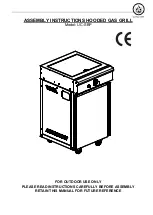
38
GRILLING
BARBECUING
ADDING ADDITIONAL CHARCOAL
USING CHARCOAL AND WOOD
To achieve the extended cooking times needed for barbecuing or
slow smoking (or if you’re using your CHARCOAL GRILL to make
enough hot dogs and hamburgers to feed an army), additional
charcoal can be added through the charcoal pan access door.
Lower the adjustable charcoal pan to its lowest setting. Open the
charcoal pan access door using an insulated grill mitt – as the
handle can be hot. Using long-handled tongs, stoke the coals
enough to allow excess ash to fall through the charcoal pan into
the slide out ash pan below. Again using insulated mitts and
long-handled tongs, add charcoal to the pan as needed and close
the access door. Raise the adjustable charcoal pan to the desired
level.
Do not use lighter fluid or instant light charcoal when adding
additional charcoal to an existing fire. This can be dangerous, and
will leave a lighter fluid aftertaste on your food.
Do not attempt to empty the ash pan of burning charcoal pieces
or hot ash. Wait until the ashes and grill have completely cooled
before emptying the grill.
See the “Cooking Methods” section for more information on
barbecuing and slow smoking.
COOKING METHODS
You can use your GRILL to cook three different ways – depending
on the type of food, and how you want to prepare it.
Grilling is cooking directly over the fire, using direct heat. This
method is the quickest and works well for foods that are tender
before you cook them – including steaks, beef or pork tenderloin,
burgers, hot dogs, sausages, chicken, seafood, etc. Vegetables are
also wonderful when grilled.
Grilling uses very high temperatures that are over 325
°
F. When
cooking at these temperatures, it is important to carefully watch
your food to keep it from burning. Also, close the lid to put out
any grease flare-up that may occur when flipping burgers or
steaks.
Barbecuing is cooking using indirect heat and smoke. This method
takes a little longer, but can be used for nearly any kind of food
you want to cook (including those above). As barbecuing uses
lower temperatures and longer cooking times – this method
works best for cuts of meat that need time to tenderize – such as
ribs, brisket, pork shoulder, wild game, etc.
Barbecuing uses temperatures from 225
°
F to 325
°
F. Try to main-
tain 275
°
F for optimal results. Use your imagination when barbe-
cuing, as the possibilities are endless!
SLOW SMOKING
Slow smoking uses much lower temperatures and much longer
cooking times. Slow smoking is actually a way to cure meats
rather than cook them. Slow smoking is ideal for turkeys, chick-
ens, beef briskets, cheese and sausage.
Slow smoking uses temperatures that range from 140
°
F to 225
°
F.
Most slow smoking recipes call for the use of saline brine that
helps preserve the meat and avoid bacterial contamination during
the cooking process. The temperature gauge on the outside of the
hood provides an accurate reading of the cooking temperature
inside the grill firebox.
CHARCOAL
Your charcoal grill is made to burn either charcoal briquettes or
natural wood lump charcoal – both of which have different
cooking attributes. Briquettes typically provide longer burn times
than lump charcoal – but lump charcoal burns hotter than
briquettes. Using the charcoal pan access door to add more
charcoal makes both briquettes and lump easy and convenient for
extended cooking times.
SMOKING WOODS
Adding smoking woods to your charcoal grill is an easy and effec-
tive way to create wonderful flavor combinations for all types of
grilled, barbecued, or slow smoked foods. Wood chips are
typically used for shorter cooking times, where chunks are better
for longer cooking times.
When choosing smoking woods, the rule of thumb is to use a
fruited hardwood – from a tree that bears a nut, fruit, or berry.
The most popular and widely available smoking woods are hickory
and mesquite. Hickory imparts a milder flavor, where mesquite is
more intense. Other common wood varieties are oak, apple,
pecan, cherry, etc.
It is important to never use pine, cedar, or kiln dried wood – and
any smoking woods should be well cured. Green wood still
contains all the sap and moisture needed to keep the tree alive,
and will impart a super strong-tasting smoke that will turn your
foods black. Also, when you try burning green wood, it is hard to
reach a good temperature, because all the moisture inside the
wood almost puts the fire out while it’s burning. Well-cured wood
lights easily, maintains cooking temperature, and produces a
great tasting smoke flavor that isn’t too strong.
The amount of smoke flavor imparted to your food can be
controlled by not just the type of wood you use (whether a mild
wood or more intense), but also by the length of time the meat is
smoked. Barbecuing typically adds more smoke flavor to food
than grilling, due to the longer cooking times. You can also control
the amount of smoke flavor by wrapping meats in aluminum foil
for part of the cooking process. Cook meat for ½ to 2/3 of the total
cooking time, or until it looks to be the perfect color. Then wrap
the meat in foil and finish cooking the meat until done
Содержание DH122212-W
Страница 8: ...08 EXPLODED VIEW ...
Страница 27: ...27 21 Place griddle 30 into storage bar as shown below 22 Install the warming rack 4 as shown ...
Страница 29: ...29 25 Install gas tank hook 44 as shown below 1 2 3 ...
Страница 30: ...30 26 Assembly is completed ...





































